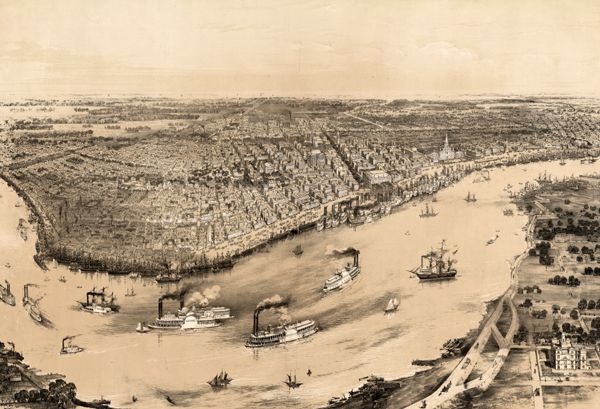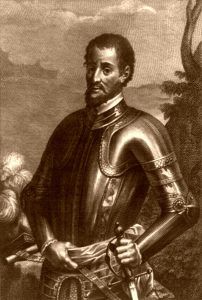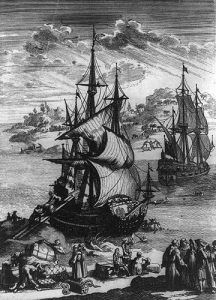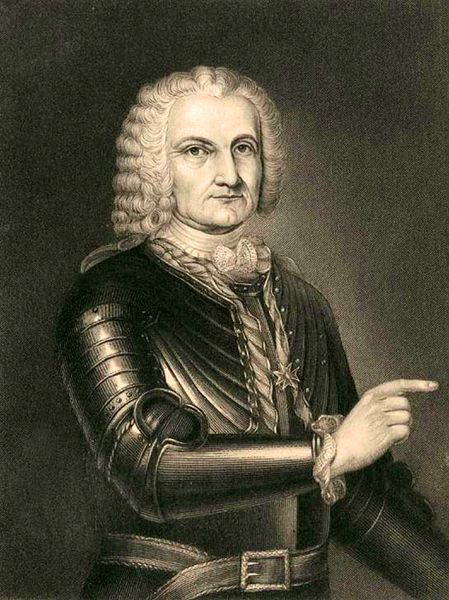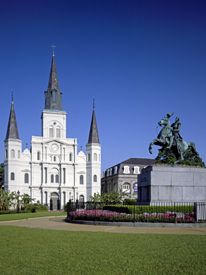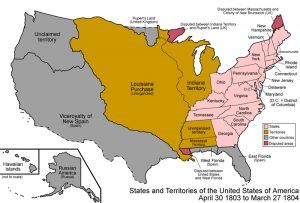By James S. Zacharie, 1885
The City Of New Orleans
It is often said that Paris is France, and it may also be said that New Orleans is Louisiana, for the history of the city is the history of the State.
The first mention of Louisiana, and of the Mississippi River being traversed by white men was in 1536, when a remnant of the ill-starred expedition of the Spaniards, under Panfilo de Narvaez, in the vain attempt to conquer Florida and seek gold, escaped in the west in direction to the Pacific Ocean. Narvaez had been put in command of the territory extending west to the River of Palms, which was probably the Colorado River.
Notwithstanding the failure of Narvaez, other adventurers were ready to follow. In 1537, Hernando de Soto, a native of Xeres, Spain, the favorite companion of Pizzaro in the conquest of Peru, sought and obtained at Valladolid, from King Charles V., permission to conquer Florida at his own cost. Landing on that coast on May 31, 1539, his well-appointed army was almost annihilated before he reached the Mississippi River two years later. In May 1542, Hernando DeSoto died at the mouth of the Red River, and, according to tradition, was buried in the waters of the Mississippi River. The miserable remnant of the expedition descended the Mississippi River to the Gulf of Mexico in July 1543, after enduring great hardships and privations. Thus does the discovery of the Father of Waters belong to the Spaniards, and no record of other white men visiting it for 130 years is in existence.
In 1673, Father Jacques Marquette, a missionary monk, and the Sieur Joliet, from Picardy, France, with a small party from the French possessions of Canada, entered the upper Mississippi River, and descended it to a point below the mouth of the Arkansas River and returned.
French Take Possession
In 1682, Robert Cavalier de la Salle, then of Fort Frontenac, Lake Ontario, was the next to descend the great river in company with Chevalier Ilenry de Tonti, an Italian veteran officer, under the patronage of King Louis XIV. On April 9, 1682, LaSalle halted on the banks of the Mississippi River, above the head of the passes, erected a cross, and, calling a notary to witness, he took solemn possession of the country in the name of his sovereign Louis XIV and named it after him — Louisiana.
In January 1699, an expedition composed of 300 men was sent out to colonize Louisiana. The expedition was commanded by Pierre Le Moyne d’Iberville, and with him were his two brothers, Sauvolle and Bienville, all sons of Charles Leinoyne. A landing was made on the Bay of Biloxi and a fort was built on a small point of land that extends out into the bay. In February, Iberville and his brother, Bienville, accompanied by Father Athanase, who had formerly been with La Salle, went in small boats to the Mississippi River, which they ascended first to the village of the Bayagoulas, where these Indians handed them letters and other relics of La Salle and Tonti. They then moved on to Pointe Coupee, which they named, and to the mouth of Red River. Returning, they traversed Lakes Maurepas and Pontchartrain, naming one after Count Maurepas, who held office under their sovereign, and the other after Count Pontchartrain, who was the Minister of Marine. On December 7th of the same year, another fleet arrived, bringing letters appointing Sauvolle as the first Governor of the Colony, and Bienville as the first Lieutenant-Governor. In 1701, Governor Sauvolle died of fever and was succeeded by Bienville. On September 14, 1712, King Louis XIV granted to Anthony Crozat a charter for 15 years, with the exclusive commerce of the whole Province, from the Gulf to the Great Lakes, and from the Alleghany Mountains to the Rocky Mountains on the West. By the terms of the charter, Crozat was to send, every year to Louisiana, two shiploads of colonists, and, after nine years, to assume all the expenses of the Colonial administration, including those of the army, in consideration of which he was to have the privilege of nominating the officers to be appointed by the King.
In 1717, Crozat, finding this colonial scheme a failure, voluntarily surrendered his charter to the King. On August 13, a Council of State was held at Versailles, presided over by the Duke of Orleans, Regent of France during the minority of Louis XV, at which, it was decided that as the colonization of Louisiana was a commercial undertaking, it should be confined to a company, and then a charter was granted and registered by the Parliament of Paris on September 16, 1717, under the name of the Company of the Indies. To this Mississippi Company, as it was sometimes called, was granted the exclusive privilege of trading with Louisiana for 25 years, to administer the colony, appoint officers, and maintain an army. Its leading spirit was John Law, a smart and scheming Scotchman, long domiciled in Paris. All the lands, coasts, harbors, and islands in Louisiana were granted to the company on the condition of furnishing to every King of France, on his accession to the throne, a crown of gold of the weight of 30 marks. Louisiana was supposed to be a Garden of Eden, with the most useful fruits, and a new Eldorado, teeming with mines of gold, silver, and precious stones. As such, the Province was placed before the public, and vast sums of money were invested in the shares of the company, with the expectation of a rich harvest of dividends. However, poor administration, disease, and wars with the Indians caused the scheme to result in a failure, and the Mississippi bubble burst, scattering ruin on all sides. On November 15, 1731, the Mississippi Company, finding the colony, not a success, after existing 14 years, surrendered their charter to the King.
Founding of New Orleans
Sailing along the shores of Lake Pontchartrain in 1718, Jean-Baptiste Le Moyne de Bienville discovered the small stream now called Bayou St. John and ascending it, encamped for the night on the Metairie Ridge. The tract of country lying between the headwaters of Bayou St. John and the banks of the Mississippi River was selected as the site of the future city. This space was then covered with a primitive forest, and, owing to the annual inundations of the river, was swampy and marshy and cut up with a thousand small ravines and pools of stagnant water when the river was low. Bienville and 50 soldiers started to clear the ground of its primitive growth, and, unmolested by the Indians, whose sole representative was an old Indian woman, who sang a chant. “The Spirit tells me,” she sang, ” that the time will come when, between the river and the lake, there will be as many dwellings for the white men as there are trees standing now. The haunts of the red man are doomed, and faint recollections and traditions concerning the very existence of his race will float dimly over the memory of his successors, as unsubstantial, as vague, and obscure as the mist which shrouds, on a winter morning; the bed of the Father of Waters.”
Bienville undoubtedly chose the site on the narrowest strip of land between the river and the lake, hoping that someday in the future the capital would have a lake and riverfront. Two plans for the city seem to have been executed, one in 1719 by Louis Henri De la Tour, Chief Engineer of the Province, and the other by Adrien de Pauger, a royal engineer employed by the Western Company. The land was laid off into 66 squares of 300 feet each which were separated by streets and were each divided into 12 lots. The lots were divided among the resident population. In 1719, an inundation drove the inhabitants from the infant city, and for a time it was abandoned.
However, just a few years later, in 1722, it became the capital of the colony, and at that time it contained 200 inhabitants and the buildings consisted of about 100 log cabins, placed without much order, a large wooden warehouse, two or three dwellings, and a storehouse which served as a chapel. The whole city was surrounded by a large ditch and fenced in with sharp stakes wedged close together. In 1727, Governor Etienne de Perier built in front of the city, a levee or embankment, 1800 yards in length and 18 feet in width on top, which served to protect the city from the annual overflows of the Mississippi River.
Lousiana Ceded to Spain
The colony of Louisiana continued for several years to belong to France until King Louis X., in return for her services as an ally during the French and Indian War, ceded Louisiana to Spain in 1762. This cession was accepted by Spain, and Antonio de Ulloa was sent out as Governor to receive the transfer of the colony. The cession of the country was violently opposed by the colonists, and De Ulloa never formally took possession, but departed with his troops, after contenting himself with only hoisting the Spanish flag on the fort at Balize and remaining there for some time. The state of affairs was reported to the Spanish king, Charles III, and his council, led by the Duke of Alba, decided on taking the colony by force. A second expedition, consisting of 24 man-of-war ships with a large force of troops commanded by General Alexander O’Reilly, a Spanish officer of renown, was sent in 1769, to take possession of the country.
Spanish Take Possession
On August 15, 1769, the French Governor, Charles Aubrey, went down the river to offer his respects to the new Spanish Governor, Alejandro O’Reilly, who was on his way up and to come to an understanding with him as to the manner and time of taking possession of the colony. On consultation, they fixed the August 18th for that ceremony. On the 16th, Aubrey returned to New Orleans, and issued a proclamation, enjoining the inhabitants of the town, and the most respectable among those of the neighboring country, to be at the ceremony and to be ready to present themselves to His Excellency Don Alexandro O’Reilly, in order to assure him of their entire submission and of their inviolate fidelity to His Catholic Majesty. On the morning of the 17th, the whole Spanish fleet, numbering 24 ships appeared in front of New Orleans. Immediately all the necessary preparations were made for landing, and flying bridges were dropped from the vessels to the bank of the river. On the 18th, early in the day, the French Governor with a numerous train of officers came to compliment the new Governor, who went ashore in company with his visitors and proceeded with them to the house which was destined for him. But, before 12 o’clock, O’Reilly returned to his fleet in order to prepare for the landing of the whole of his forces.
At 5 o’clock in the afternoon, a gun, fired by the flagship, gave the signal for the landing of the Spaniards. The French troops and the militia of the colony, with Aubrey at their head, were already drawn up in a line parallel to the river, in front of the ships, in that part of the public square which is nearest to the church. On the signal being heard the Spanish troops were seen pouring out of the fleet in solid columns and moving with admirable precision to the points which had been designated to them. These troops, numbering some 2,600 men, were among the choicest of Spain and had been picked by O’Reilly himself. With colors flying and with the rapidity of motion of the most practiced veterans, they marched on, battalions after battalions, exciting the admiration and the awe of the population with their martial aspect and their brilliant equipment. The heavy infantry drew themselves up in perpendiculars, on the right and left wings of the French, thus forming three sides of a square Then came a heavy train of artillery of 50 guns, the light infantry and the companies of mountain riflemen, with the cavalry, which was composed of 40 dragoons and 50 mounted militiamen from Havana. All these corps occupied the fourth side of the square near the river and in front of the French, who were drawn up near the Cathedral. All the vessels were dressed in their colors, and the riggings were alive with the Spanish sailors in their holiday apparel. Of a sudden, they gave five long and loud shouts of “Viva el Rey—Long live the King,” to which the troops in the square responded in a similar manner. All the bells of the town pealed merrily; a simultaneous discharge from the guns of the 24 Spanish vessels enveloped the river in smoke; with emulous rapidity the 50 guns that were on the square roared out their salute, making the ground tremble as if convulsed with an earthquake; all along the dark lines of the Spanish infantry flashed a sheet of fire, and the weaker voice of musketry, also shouting in jubilation, attempted to vie with the thunder of artillery. All this pomp and circumstance of war announced that General O’Reilly was landing.
He soon appeared in the square, where he was received with all the honors due to a Captain-general, drums beating, banners waving, and all sorts of musical instruments straining their brazen throats, and by their wild and soul-stirring sounds causing the heart to leap and the blood to run electrically through the hot veins. He was preceded by splendidly accoutered men who bore heavy silver maces, and the whole of his retinue, which was of the most imposing character, was well calculated to strike the imagination of the people. With a slightly halting gait, he advanced towards the French Governor, who, with the members of the Council and all the men of note in the colony, stood near a mast that supported the flag of France.
Immediately behind O’Reilly followed the officers of the colonial administration of Louisiana, Don Joseph Loyola, the commissary of war and intendant; Don Estevan Gayarre, the Contador, or royal comptroller, and Martin Navarro, the treasurer, who were to be restored to their respective functions, which had been interrupted by the revolution. “Sir,” said O’Reilly to Aubrey, “I have already communicated to you the orders and the credentials with which I am provided, to take possession of this colony in the name of His Catholic Majesty, and also the instructions of His most Christian Majesty that it be delivered up to me. I beg you to read them aloud to the people.”
Aubrey complied with this request and then addressing the colonists, by whom he was surrounded, said: “Gentlemen, you have just heard the sacred orders of their most Christian and Catholic Majesties in relation to the Province of Louisiana, which is irrevocably ceded to the crown of Spain. From this moment you are the subjects of His Catholic Majesty, and by virtue of the orders of the King, my master, I absolve you from your oath of fidelity and obedience to His most Christian Majesty.”
Then turning to O’Reilly, Aubrey handed to him the keys to the gates of the town. The banner of France sunk from the head of the mast. where it waved and was replaced by that of Spain. Following the example and the orders of Aubrey, the French shouted five times, “Viva el Reyl —Long live the King!” which was repeated three times by the Spanish troops, who recommenced their firing in unison with the fleet. Then O’Reilly, followed by the principal Spanish officers, and accompanied by Aubrey and his retinue, proceeded to the Cathedral where he was received at the threshold by the clergy with all the honors of the Pallium, and with the other usual solemnities.
The curate or vicar-general, in the name and on behalf of the people, addressed to the General a pathetic harangue, coupled with the most caressing protestations of fidelity on his part. The General answered with concise eloquence, declaring his readiness to protect religion, to cause the ministers of the sanctuary to be respected, to support the authority of the King and the honor of his arms, to devote himself to the public good, and to do justice to all. He then entered the church, where a Te Deum was sung, during which the troops and the fleet renewed their discharges in token of rejoicing. When the pious ceremony was over, O’Reilly and Aubrey returned to the public square, where all the Spanish troops filed off before the Governors in the most redoubtable order and equipage, says Aubrey, in one of his dispatches, and, after having saluted them retired to their respective quarters.”
New Orleans Fortified by the Spanish
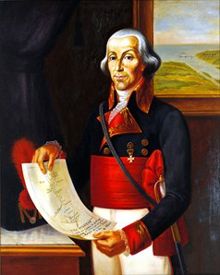
Baron de Carondelet
In 1794, the Spanish Governor, Baron de Carondelet, fortified the city after a plan drawn by himself. His objective was not only to provide for a defense from outside enemies but to place his guns so that they could bear upon the town and keep the inhabitants in subjection. Collot, a French General, who visited New Orleans in 1796, described the fortifications as consisting of:
“of five small forts and a great battery. On the side which fronts the river are two forts, which command the river and the road. Their shape is that of a regular pentagon, with a parapet 18 feet thick, coated with brick, with a ditch and covered way. In each of these forts are barracks for the accommodation of 150 men, and a powder magazine. Their artillery is composed of a dozen twelve and eighteen-pounders. Between these two forts—that is, that on the right, which is most considerable — is called “St. Charles,” the other “St. Louis.” In the rear, and to cover the city on the land side, are three other forts. There is one at each of the two salient angles of the long square forming the city, and a third between the two, a little beyond the line, so as to form an obtuse angle. These three forts have no covered way, and are not revetted, but are merely strengthened with friezes and palisades. They are armed with guns and have accommodations for 100 men. The one on the right is called Fort Burgundy, that on the left St. Ferdinand, and that of the middle St. Joseph. The five forts and the battery cross their fire with one another and are connected by a ditch of 40 feet in width by seven in depth. With the earth taken out of the ditch, there has been formed on the inside of a parapet three feet high, on which have been placed, closely serried, a line of 12 feet pickets. The back of those pickets is a small causeway. The earth has been cast so as to render the slope exceedingly easy and accessible. Three feet of water is always kept up in the moats, even during the driest season of the year, by means of ditches communicating with a draining canal. It cannot be denied that these miniature forts are well kept and trimmed up. But, particularly on account of their ridiculous distribution, and also on account of their want of capaciousness, they look more like playthings Intended for babies than military defenses. For there is not one which cannot be stormed, and which 500 determined men could not carry a sword in hand. Once a master of one of the principal forts, either St. Louis or St Charles, the enemy would have no need of minding the others, because, bringing the guns to bear upon the city, it would be forced to capitulate immediately, or be burnt up in less than an hour and have its inhabitants destroyed, as none of the forts can admit more than 150 men. We believe that Monsieur de Carondelet when he adopted this bad system of defense, thought more of securing the obedience of the subjects of his Catholic Majesty than of providing a defense against the attack of a foreign enemy, and, in this point of view, he may be said to have completely succeeded.”
Retrocession of Louisiana to France
Bv the treaty of San lldephonso, made on October 1, 1800, Spain engaged herself to cede Louisiana to France. This treaty was kept secret, as France, who was then at war with England, feared that it would be seized by that power. France sold Louisiana to the United States, and appointed Laussat Prefect of the colony for the intervening time, and also a commissioner to transfer the colony to the United States.
On November 30, 1800, the Marquis of Casa-Calvo and Governor Salcedo, commissioners on the part of Spain, and Laussat, commissioner on the part of France, accompanied by a huge retinue of the clergy, all the civil and military officers in the employ of France and Spain, and many other persons of distinction, met in the City Hall, where Laussat exhibited to the Spanish commissioners an order from the King of Spain for the delivery of the colony, and his credentials from the French Government to receive it. Thereupon, the keys of New Orleans were handed to Laussat, and Salcedo and Casa-Calvo declared that, from that moment, according to the powers vested in them, they put the French commissioners in possession of Louisiana and its dependencies, in all their extent, such as they were ceded by France to Spain and such as they remained under the successive treaties made between his Catholic Majesty and other Powers. They further declared that they absolved from their oath of fidelity and allegiance to the crown of Spain such of his Catholic Majesty’s subjects in Louisiana as might choose to live under the authority of the French Republic. A record was made of these proceedings in French and Spanish, and the three commissioners walked to the main balcony, where the Spanish flag was saluted by a discharge of artillery on its descent from a pole erected on the public square in front of the City Hall; that of the French Republic was greeted in the same manner on its ascent. The square was occupied by the Spanish troops and some of the militia of the colony. It was remarked that the militia had mustered up with difficulty, and did not exceed one hundred and fifty men. It was an indication of an unfavorable feeling, which had been daily gaining strength, and which Laussat attributed, in his dispatches, to the intrigues of the Spanish authorities. Although the weather had been tempestuous in the preceding night and in the morning and continued to be threatening, the crowd around the public square was immense and filled, not only the streets but also the windows and even the very tops of the neighboring houses.
Sale of and Possession of Lousiana to the United States
Bonaparte, fearing that England would seize Louisiana, authorized his ministers, Barbe Marbois and Talleyrand, to enter into negotiations with the United States, represented by Livingston and Monroe. The negotiations resulted in a treaty being signed at Paris on April 30, 1803, by which France ceded Louisiana to the United States for 15 million dollars, of which four million was to be devoted to the payment of what was due by France to the citizens of the United States. When Bonaparte was informed of the conclusion of the treaty, he made the celebrated remark: “This accession of territory strengthens forever the power of the United States, and I have just given to England a maritime rival that will, sooner or later, humble her pride.”
“On Tuesday, December 20, 1803, the French Prefect, Laussat, ordered all the militia companies to be drawn up under arms, on the public square, in front of the City Hall. The crowd of spectators was immense, and the finest weather favored the curiosity of the public. The Commissioners of the United States, Claiborne, and Wilkinson, arrived at the gates of the city with their troops, and, before entering, were reconnoitered, according to military usages, by a company of the militia grenadiers. The American troops, on entering the city, were greeted with a salute of 21 guns from the forts, and formed on the opposite side of the square, facing the militia. At the City Hall, the Commissioners of the United States exhibited their powers to Laussat. The credentials were publicly read, next to the treaty of cession, the powers of the French Commissioner, and, finally, the process-verbal. The Prefect proclaimed the delivery of the Province to the United States, handed the keys of the city to Claiborne, and declared that he absolved from their allegiance to the French Republic such of the inhabitants as might choose to pass under the new domination. Claiborne now rose and offered to the people his congratulations on the event which irrevocably fixed their political existence and no longer left it open to the caprices of chance.
He assured them that the United States received them as brothers, and would hasten to extend to them a participation in the invaluable rights forming the basis of their own unexampled prosperity, and that, in the meanwhile, the people would be protected in the enjoyment of their liberty, property, and religion; that their commerce would be favored, and their agriculture encouraged.
The three Commissioners then went to one of the balconies of the City Hall. On their making their appearance, the French flag, which was floating at the top of a pole in the middle of the square, came down, and the American flag went up. Thus ended the French domination, if it can be so called, 20 days after it had begun. The Spanish Government had lasted 34 years and a few months.”
Lousiana as a Territory and a State
Claiborne was appointed Governor of the province by the President and immediately proceeded to organize a government. In 1804, an act was passed by Congress dividing Louisiana into two parts. The upper portion was called the District of Louisiana, with St. Louis as a capital, and the lower portion was the Territory of Orleans, with New Orleans as the capital. This act remained in force until 1805, when a new act was passed reorganizing the Territory of Orleans, with an elective legislative council.
In 1812, Congress called a Constitutional Convention. This Convention adopted a Constitution, modeled after that of Kentucky, and, on April 8, 1812, Congress passed the act admitting Louisiana into the Onion as the 18th State. A portion of West Florida, that is, the country east of the Mississippi River and north of Lake Pontchartrain, was annexed, and Louisiana thus constituted and comprised 41,347 square miles.
It became one of the United States of America, and Claiborne was elected the first Governor of the new State. During the administration of Governor Claiborne, the United States, being at war with England, an expedition was sent by the British against New Orleans, which resulted disastrously in the Battle of New Orleans and a loss to the attackers.
Louisiana as a State
After the defeat of the British and their retreat, peace was declared and immediately trade revived and internal improvements were commenced. The culture of sugar developed itself every year, and immigration set in. The State and city increased in population and continued to grow in prosperity until the civil war was declared.
On January 26, 1861, the Ordinance of Secession was adopted by the Convention and Louisiana joined the Confederate States of America. Many regiments of troops were sent to the Confederate Army and took their share of the perils of the battlefield.
In April 1862, the Federal fleet under Admiral Farragut passed the forts and batteries on the river and New Orleans was captured. The city was held by United States forces, and from it at different times were sent expeditions to the interior. These expeditions were not successful in the State, as, with the exception of New Orleans and its immediate vicinity, it remained in the hands of the Confederates. On the approach of the Federal forces, the capital was evacuated by the State officers, and the capital was transferred to Shreveport. During this period a convention was called and a State government was organized in New Orleans under the protection of the Federal army.
The war caused great destruction in Louisiana. Sugar houses and gins were burned and the planting of sugar was suspended, but the large amount of cotton in the interior gave a start to trade again. The State Government of Shreveport ceased with the cessation of hostilities, and the only State authorities existing were those of New Orleans. These authorities continued to act until 1866.
In 1866, the July Riots took place and Congress immediately put the State under military rule with a temporary State government. In 1868, a convention formed a new constitution and was recognized by Congress as a State. Political matters thus assumed an unsettled state for several years and remained so until 1879, when a convention was called to form a new constitution, and, thenceforth, all became settled and the people directed their energies to build the State up again and restore its cities and plantations to their antebellum prosperity.
Compiled and edited by Kathy Alexander/Legends of America, updated May 2020.
Source: New Orleans Guide, by James S. Zacharie, New Orleans News Company, 1885.
Also See:

